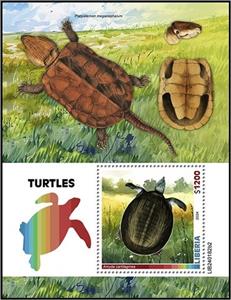Souvenir Sheet: Amyda cartilaginea (Liberia 2024)
Amyda cartilaginea (Liberia 2024)
05 January (Liberia ) within release Turtles (2024) goes into circulation Souvenir Sheet Amyda cartilaginea face value 1,200 Liberian dollar
| Souvenir Sheet Amyda cartilaginea in catalogues | |
|---|---|
| Colnect codes: | Col: LR 2024.01.05-269 |
Souvenir Sheet is square format.
Also in the issue Turtles (2024):
- Souvenir Sheet - Amyda cartilaginea face value 1,200;
- Souvenir Sheet - Kinosternon scorpioides face value 1,200;
- Mini Sheet - Turtles face value 3*400;
Souvenir Sheet Amyda cartilaginea it reflects the thematic directions:
Animals are multicellular, eukaryotic organisms of the kingdom Animalia (also called Metazoa). All animals are motile, meaning they can move spontaneously and independently, at some point in their lives. Their body plan eventually becomes fixed as they develop, although some undergo a process of metamorphosis later on in their lives. All animals are heterotrophs: they must ingest other organisms or their products for sustenance.
Reptiles are tetrapod (four-limbed vertebrate) animals in the class Reptilia, comprising today's turtles, crocodilians, snakes, amphisbaenians, lizards, tuatara, and their extinct relatives. The study of these traditional reptile orders, historically combined with that of modern amphibians, is called herpetology. Because some reptiles are more closely related to birds than they are to other reptiles (e.g., crocodiles are more closely related to birds than they are to lizards), the traditional groups of "reptiles" listed above do not together constitute a monophyletic grouping (or clade). For this reason, many modern scientists prefer to consider the birds part of Reptilia as well, thereby making Reptilia a monophyletic class.
Turtles are reptiles of the order Testudines, characterized by a special shell developed mainly from their ribs. Modern turtles are divided into two major groups, the Pleurodira (side necked turtles) and Cryptodira (hidden necked turtles), which differ in the way the head retracts. There are 360 living and recently extinct species of turtles, including land-dwelling tortoises and freshwater terrapins. They are found on most continents, some islands and, in the case of sea turtles, much of the ocean. Like other amniotes (reptiles, birds, and mammals) they breathe air and do not lay eggs underwater, although many species live in or around water.



